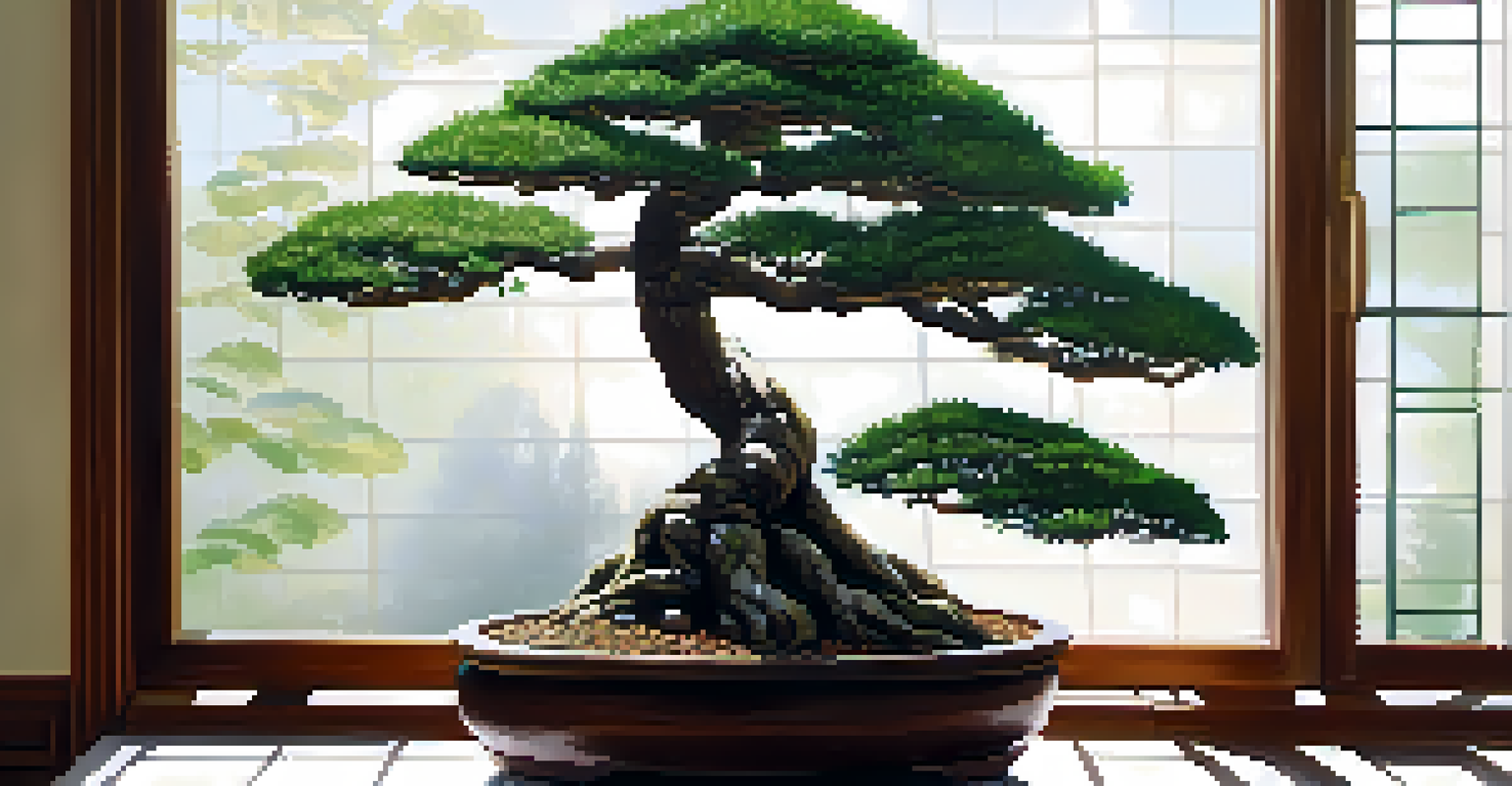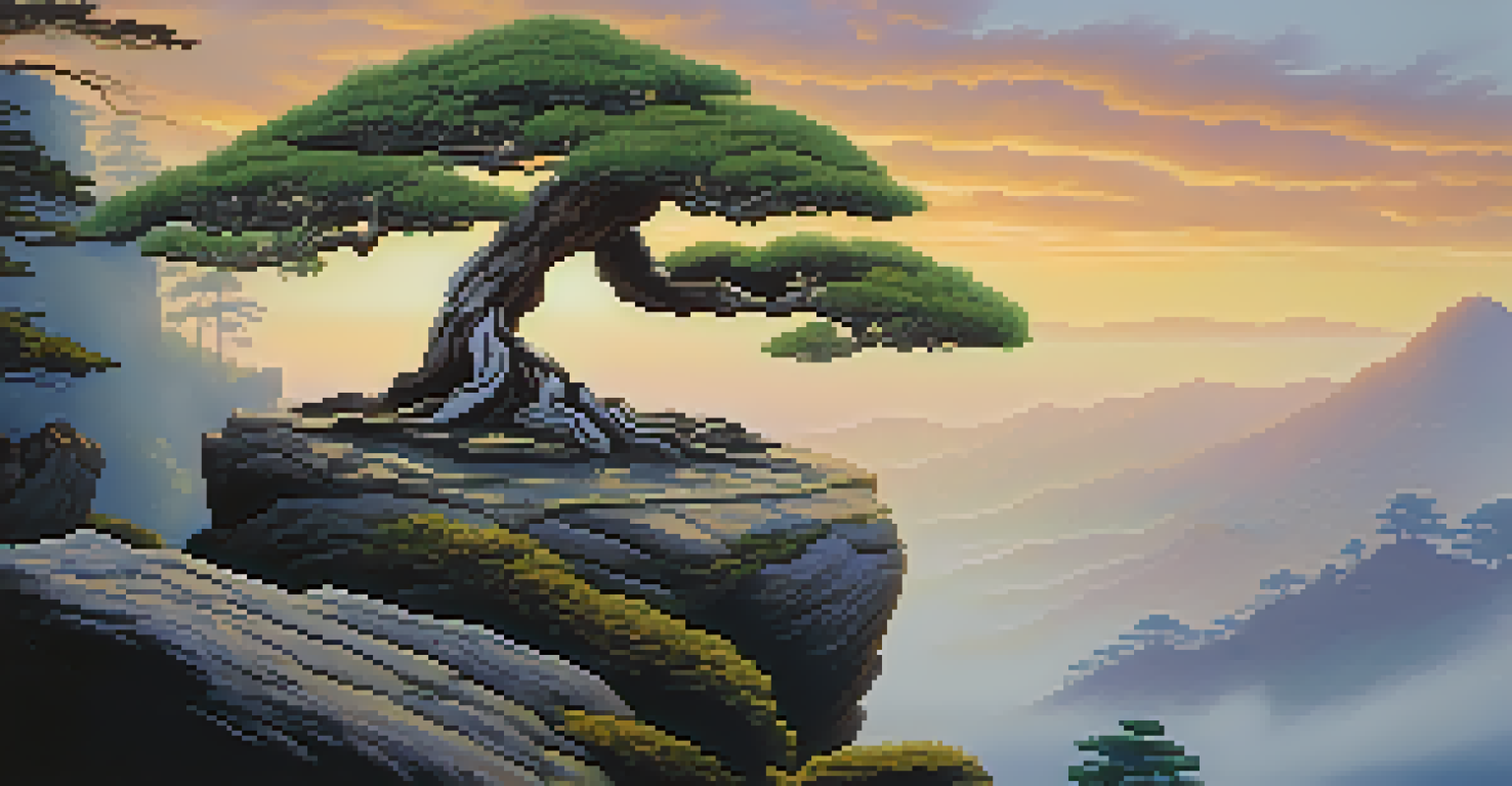Creating Bonsai Styles: From Formal Upright to Cascade

Understanding the Art of Bonsai and Its Styles
Bonsai is more than just a plant; it's an art form that embodies patience, skill, and a deep connection with nature. Originating from ancient China and further refined in Japan, bonsai involves cultivating miniature trees in containers, mimicking the grandeur of full-sized trees. Each bonsai style reflects different aesthetics and philosophies, allowing enthusiasts to express their creativity.
The creation of a bonsai is the perfect synthesis of nature and art.
Bonsai styles are categorized based on their shape, growth pattern, and overall visual appeal. Some popular styles include the Formal Upright, Informal Upright, and Cascade, each telling a unique story through the tree's form. Understanding these styles is essential for any aspiring bonsai artist, as it guides their approach to shaping and nurturing their creations.
As you delve into bonsai, it's crucial to appreciate the balance between nature and artistry. Each style requires different techniques and care, making it a rewarding journey for those who invest time and effort. Whether you're a beginner or a seasoned practitioner, learning about these styles opens a world of possibilities for your bonsai endeavors.
The Formal Upright Style: Structure and Elegance
The Formal Upright style, known as 'Chokkan' in Japanese, is characterized by its straight, vertical trunk and symmetrical branches. This style conveys a sense of stability and strength, often resembling a majestic tree found in nature. To create this style, the trunk should taper gradually from the base to the top, giving it a natural yet polished look.

When shaping a Formal Upright bonsai, the key is to maintain balance throughout the tree. The branches should be evenly spaced and proportionate in size, creating a harmonious silhouette. Regular pruning and wiring are essential to achieve the desired shape, allowing the tree to flourish while preserving its structural integrity.
Bonsai as an Artistic Journey
Bonsai is not just about growing trees; it's an artistic practice that fosters creativity and a deep connection with nature.
A great example of this style is the Japanese Black Pine, which showcases the beauty of the Formal Upright form. By cultivating this particular bonsai, you can appreciate the elegance it brings to any space, embodying both nature's grandeur and the artist's touch. This style sets the foundation for understanding more advanced bonsai techniques.
Exploring the Informal Upright Style: Natural Beauty
The Informal Upright style, or 'Moyogi,' breaks away from the rigid symmetry of the Formal Upright. Instead, it features a trunk that curves gently, reflecting the organic shapes often seen in nature. This style captures the essence of a tree swayed by the wind, adding an element of dynamic beauty to your bonsai collection.
The greatest gift of the garden is the restoration of the five senses.
To cultivate an Informal Upright bonsai, aim for a relaxed and flowing trunk design. The branches should also follow the curve of the trunk, enhancing the tree's natural appearance. This style allows for more creative freedom, encouraging bonsai artists to experiment with their designs while staying true to the tree's inherent character.
A popular choice for this style is the Ficus bonsai, known for its adaptability and resilience. Its ability to thrive indoors makes it a favorite among beginners. By embracing the Informal Upright style, you can create a captivating bonsai that tells a story of growth and resilience, connecting you more deeply with the art of bonsai.
The Cascade Style: Defying Gravity with Elegance
The Cascade style, or 'Kengai,' is a stunning representation of nature's resilience, featuring a tree that appears to cascade downwards. This style mimics trees that grow on steep cliffs, showcasing how they adapt to challenging environments. The dramatic effect of a cascade bonsai evokes a sense of movement and life, making it a showstopper in any collection.
Creating a Cascade bonsai requires careful planning and technique. The trunk should be trained to extend downward, with branches that follow the natural flow of the tree. Using a sturdy pot with adequate drainage is essential to support the tree's growth and maintain its health as it develops its unique shape.
Key Bonsai Styles Explained
Understanding various bonsai styles, such as Formal Upright and Cascade, is essential for shaping and nurturing your trees effectively.
A perfect candidate for the Cascade style is the Juniper bonsai, renowned for its flexibility and attractive foliage. As you nurture a Cascade bonsai, you'll witness the transformation of a simple plant into a breathtaking work of art, illustrating the power of nature's beauty and your artistic vision.
Choosing the Right Tree for Your Bonsai Style
Selecting the right tree species is crucial for successfully creating a specific bonsai style. Each species has unique characteristics, growth habits, and requirements that influence how it can be shaped. For example, some trees, like the Japanese Maple, are ideal for the Formal Upright style due to their natural tapering trunks and vibrant foliage.
Consider factors such as climate, available space, and your level of experience when choosing a tree. Beginners might find easier species like the Ficus or Juniper more forgiving, while seasoned artists can experiment with more challenging varieties. Understanding the individual needs of each tree will greatly enhance your bonsai journey.
Ultimately, the tree you select should resonate with your artistic vision and personal preferences. By aligning your choice with your desired bonsai style, you set the stage for a fulfilling and successful cultivation experience. Remember, the right tree is the foundation upon which your bonsai masterpiece will grow.
Pruning Techniques for Shaping Your Bonsai
Pruning is an essential technique in bonsai cultivation, allowing you to shape and maintain your tree's desired style. This process involves cutting back new growth to encourage branching and maintain the overall design. It's important to approach pruning with care, as it directly impacts the health and aesthetics of your bonsai.
Different bonsai styles require specific pruning techniques. For instance, the Formal Upright style often demands precise cuts to maintain its symmetrical look, while the Informal Upright allows for more natural growth. Timing is also crucial; typically, pruning is best done during the growing season when the tree can recover quickly.
Essential Care Techniques
Proper watering and nutrition are crucial for maintaining the health and vitality of your bonsai, enhancing its beauty over time.
As you gain experience, you'll develop a better understanding of how your bonsai responds to pruning. Keeping a journal of your pruning activities can help track your tree's development over time. With practice, you'll find that pruning becomes a meditative process, enhancing both your skills and your bond with your bonsai.
Wiring Techniques: Guiding Your Bonsai's Growth
Wiring is another vital technique in bonsai cultivation, allowing you to shape and guide the branches and trunk as they grow. By carefully wrapping wire around the limbs, you can bend and position them to achieve your desired style. This technique is particularly useful for creating the sweeping curves seen in the Informal Upright and Cascade styles.
When wiring your bonsai, it's essential to use the right gauge of wire, as thicker wire provides more strength but can also damage delicate branches. Additionally, monitor your tree regularly to ensure the wire doesn't cut into the bark, which could harm its growth. Removing the wire promptly after the tree has set its shape is crucial to prevent any lasting damage.

As you become more adept at wiring, you'll discover a new level of creativity in shaping your bonsai. This technique not only enhances the tree's aesthetics but also reinforces your understanding of its growth patterns. With patience and practice, wiring will become an integral part of your bonsai artistry, allowing you to bring your vision to life.
Caring for Your Bonsai: Watering and Nutrition Essentials
Caring for your bonsai goes beyond shaping; it also involves understanding its watering and nutritional needs. Proper watering is crucial, as bonsai trees can easily suffer from overwatering or underwatering. A good rule of thumb is to check the topsoil; if it feels dry, it's time to water. Consistent monitoring will help you establish a routine that keeps your tree healthy.
Nutritional needs also vary by species and season. During the growing season, using a balanced fertilizer can provide essential nutrients that support growth and vitality. It's important to follow the manufacturer's instructions regarding application rates and frequency to avoid over-fertilizing, which can harm your bonsai.
By paying attention to watering and nutrition, you ensure your bonsai thrives as it grows into a stunning piece of art. Developing a care routine will deepen your connection with your tree, allowing you to appreciate the beauty of its growth. Caring for your bonsai is a rewarding journey that brings the artist and nature closer together.